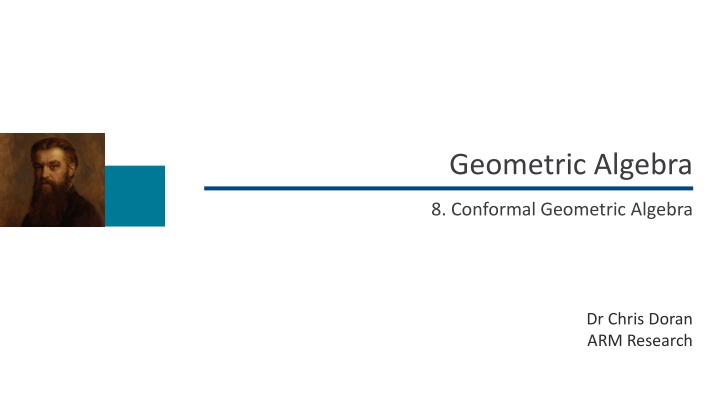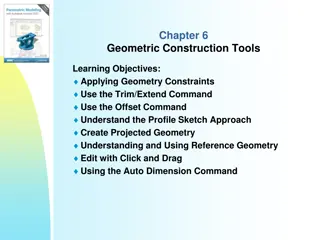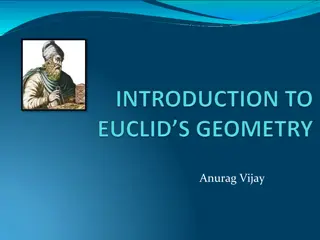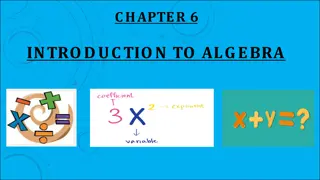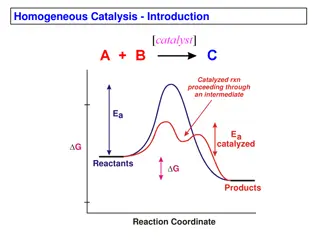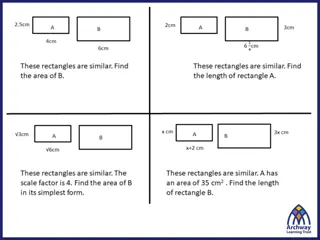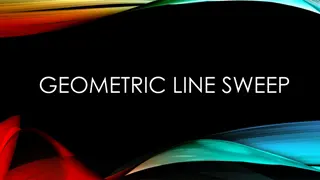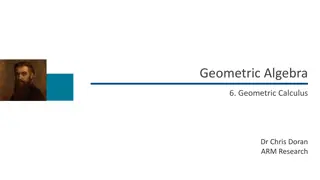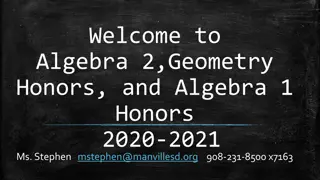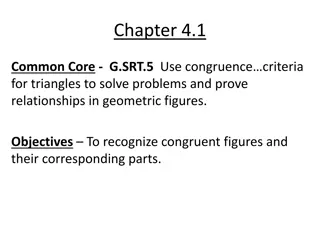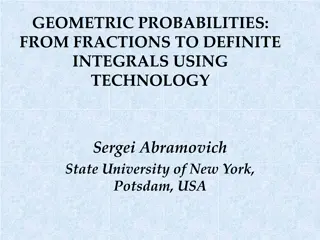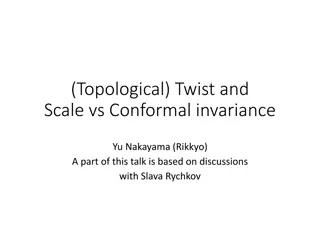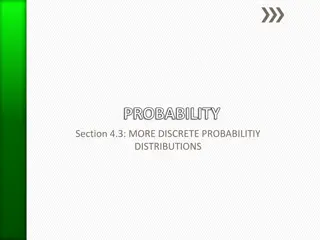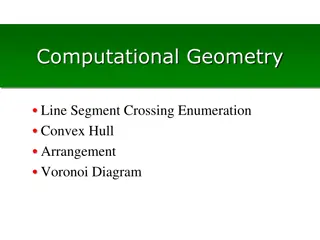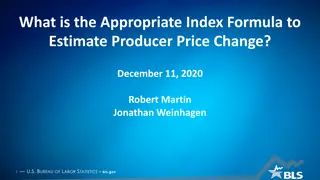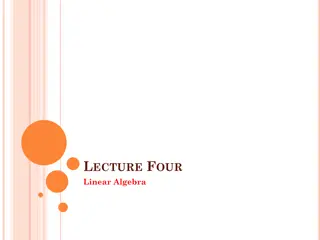Conformal Geometric Algebra for Homogeneous Geometry
This content delves into the exploration of treating points as vectors in a homogeneous viewpoint, emphasizing the significance of preserving geometric meaning despite scaling. It discusses the direct interpretation of the inner product of vectors as the distance between points, aiming to meet various demands in one algebra. The journey leads to understanding distance concepts in a Euclidean representation and the introduction of a point at infinity for a comprehensive geometric perspective.
Download Presentation

Please find below an Image/Link to download the presentation.
The content on the website is provided AS IS for your information and personal use only. It may not be sold, licensed, or shared on other websites without obtaining consent from the author.If you encounter any issues during the download, it is possible that the publisher has removed the file from their server.
You are allowed to download the files provided on this website for personal or commercial use, subject to the condition that they are used lawfully. All files are the property of their respective owners.
The content on the website is provided AS IS for your information and personal use only. It may not be sold, licensed, or shared on other websites without obtaining consent from the author.
E N D
Presentation Transcript
Geometric Algebra 8. Conformal Geometric Algebra Dr Chris Doran ARM Research
L8 S2 Motivation Projective geometry showed that there is considerable value in treating points as vectors Key to this is a homogeneous viewpoint where scaling does not change the geometric meaning attached to an object We would also like to have a direct interpretation for the inner product of two vectors This would be the distance between points Can we satisfy all of these demands in one algebra?
L8 S3 Inner product and distance Suppose X and Y represent points Would like Quadratic on grounds of units Immediate consequence: Represent points with null vectors Borrow this idea from relativity Also need to consider homogeneity Idea from projective geometry is to introduce a point at infinity: Key idea was missed in 19th century
L8 S4 Inner product and distance Natural Euclidean definition is But both X and Y are null, so As an obvious check, look at the distance to the point at infinity We have a concept of distance in a homogeneous representation Need to see if this matches our Euclidean concept of distance.
L8 S5 Origin and coordinates Pick out a preferred point to represent the origin Look at the displacement vector Would like a basis vector containing this, but orthogonal to C Add back in some amount of n Get this as our basis vector:
L8 S6 Origin and coordinates Now have Write as is negative Euclidean vector from origin Historical convention is to write
L8 S7 Is this Euclidean geometry? Look at the inner product of two Euclidean vectors Checks out as we require The inner product is the standard Euclidean inner product Can introduce an orthonormal basis
L8 S8 Summary of idea Represent the Euclidean point x by null vectors Distance is given by the inner product Normalised form has Basis vectors are Null vectors
L8 S9 1D conformal GA Basis algebra is NB pseudoscalar squares to +1 Simple example in 1D
L8 S10 Transformations Any rotor that leaves n invariant must leave distance invariant Rotations around the origin work simply Remaining generators that commute with n are of the form
L8 S11 Null generators Taylor series terminates after two terms Since Conformal representation of the translated point
L8 S12 Dilations Suppose we want to dilate about the origin Have Generate this part via a rotor, then use homogeneity To dilate about an arbitrary point replace origin with conformal representation of the point Define Rotor to perform a dilation
L8 S13 Unification In conformal geometric algebra we can use rotors to perform translations and dilations, as well as rotations Results proved at one point can be translated and rotated to any point
L8 S14 Geometric primitives Find that bivectors don t represent lines. They represent point pairs. Look at Point a Point b Point at infinity Points along the line satisfy This is the line
L8 S15 Lines as trivectors Suppose we took any three points, do we still get a line? Need null vectors in this space Up to scale find The outer product of 3 points represents the circle through all 3 points. Lines are special cases of circles where the circle include the point at infinity
L8 S16 Circles Everything in the conformal GA is oriented Objects can be rescaled, but you mustn t change their sign! Important for intersection tests Radius from magnitude. Metric quantities in homogenous framework If the three points lie in a line then Lines are circles with infinite radius All related to inversive geometry
L8 S17 4-vectors 4 points define a sphere or a plane If the points are co-planar find So P is a plane iff Unit sphere is Radius of the sphere is Note if L is a line and A is a point, the plane formed by the line and the point is
L8 S18 5D representation of 3D space Object Grade Dimension Interpretation Scalar 0 1 Scalar values Vector 1 5 Points (null), dual to spheres and planes. Bivector 2 10 Point pairs, generators of Euclidean transformations, dilations. Trivectors 3 10 Lines and circles 4-vectors 4 5 Planes and spheres Pseudoscalar 5 1 Volume factor, duality generators
L8 S19 Angles and inversion Angle between two lines that meet at a point or point pair Reflect the conformal vector in e Works for straight lines and circles! All rotors leave angles invariant generate the conformal group The is the result of inverting space in the origin. Can translate to invert about any point conformal transformations
L8 S20 Reflection 1-2 plane is represented by In the plane Out of the plane So if L is a line through the origin The reflected line is But we can translate this result around and the formula does not change Reflects any line in any plane, without finding the point of intersection
L8 S21 Intersection Use same idea of the meet operator Duality still provided by the appropriate pseudoscalar (technically needs the join) Example 2 lines in a plane 2 points of intersection 1 point of intersection 0 points of intersection
L8 S22 Intersection Circle / line and sphere / plane 2 points of intersection 1 point of intersection 0 points of intersection All cases covered in a single application of the geometric product Orientation tracks which point intersects on way in and way out In line / plane case, one of the points is at infinity
L8 S23 Intersection Plane / sphere and a plane / sphere intersect in a line or circle Norm of L determines whether or not it exists. If we normalise a plane P and sphere S to -1 can also test for intersection Sphere above plane Sphere and plane intersect Sphere below plane
L8 S24 Resources geometry.mrao.cam.ac.uk chris.doran@arm.com cjld1@cam.ac.uk @chrisjldoran #geometricalgebra github.com/ga
